Flybe's stirred not shaken strategy sees it through, for now
Flybe has a different strategy from most other airlines. That's probably why it has a different bottom line, reporting an improved pre-tax profit of GBP35.4 million for FY07/08 (12 months to 31-Mar-08), on a 46% year-on-year increase in revenue, to GBP535.9 million - and vindicating its acquisition of BA Connect in Mar-07 (Flybe has moved quickly to achieve the originally estimated cost savings and revenue gains of more than GBP40 million p/a, while ending BA Connect's GBP40 million annual loss).
Flybe financial/traffic highlights for 12 months ended 31-Mar-08
|
Currency: GBP |
% Change |
|
|---|---|---|
|
Revenue (mill) |
535.9 |
+45.8% |
|
Operating costs (mill) |
436.7 |
+39.6% |
|
Profit before tax (mill) |
35.4 |
+131% |
|
Net profit (loss) (mill) |
34.9 |
-19.9% |
|
Operating profit^ |
38.2 |
+117.0% |
|
Operating profit (exc exceptional items) (mill) |
30.8 |
+503.9% |
|
Operating margin |
7.1% |
+2.3 ppts |
|
Traffic pax (mill) |
7.0 |
+34.6% |
Flybe revenue: 2003 to 1Q09 (year ended 31-Mar)
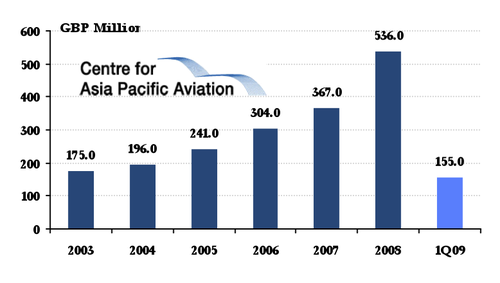
1Q09 results continuing the strong performance from FY08/09
More importantly in the current tough conditions, the first quarter of the current financial year appears to have continued the strong performance, with pre-tax earnings of GBP12.2 million, up 14% on 1Q08, despite a 60% year-on-year increase in fuel costs to GBP32.7 million. Flybe's fuel cost per seat was also up, by 44% year-on-year.
However, there is one significant niggling detail: despite the bare bones reporting of a private company, the 18% increase in passenger numbers for the quarter suggests a reduction in yield (or, at least, in profit per head).
Flybe financial/traffic highlights for three months ended 30-Jun-08
|
Currency: GBP |
% Change |
|
|---|---|---|
|
Revenue (mill) |
155 |
+13.7% |
|
Profit before tax (mill) |
12.2 |
+14% |
|
Pre-tax profit margin |
7.9% |
- |
|
Traffic pax (mill) |
2.0 |
+18% |
To reduce Winter expansion from 16% to a more modest 6%; beginning to see slowing of corporate travel
As with everyone else, the future is the tough bit to predict. Flybe appears confident, while conceding that it will be reducing its Winter season expansion from 16% down to a more modest 6%.
The reduction will equate to 400,000 fewer seats than expected between Oct-08 and Mar-09, with frequency to be reduced on service to European destinations including Paris, Frankfurt and Brussels, as the airline is "beginning to see that some of the corporate accounts slowing down"
Fleet substitution plan to result in 19.4% capacity increase
Bombardier will be watching this situation with interest, as the carrier is sitting on the company's largest firm order, for 60 78-seat Q400s, which are being delivered over the next three years as part of the carrier's refleeting strategy. The carrier also has orders for 14 118-seat Embraer-195s. The fleet's substitution plan, from E-145s to BAe 146-300s will result in a planned capacity increase of 19.4% over the 20 month period between 31-Mar-08 and 31-Oct-09.
Flybe fleet substitution plan
|
Aircraft type |
31-Mar-08 |
31-Oct-09 |
|---|---|---|
|
Q400 (78 seats) |
37 |
60 |
|
E-145 (49 seats) |
23 |
- |
|
E-195 (118 seats) |
10 |
14 |
|
BAe 146-300s (112 seats) |
1 |
- |
|
Total Aircraft |
71 |
74 |
|
Total seats |
5,305 |
6,332 |
Benefing from "rigorous fuel hedging policy"
Flybe is following a "rigorous fuel hedging policy", with 76% of its fuel needs for this calendar year covered at "attractive rates" (although no further details were disclosed). With this hedging position, Flybe has one of the most extensive hedging programmes among its European competitors.
Select European carriers' fuel hedging positions
|
Carrier |
Information date |
Hedging Position |
|---|---|---|
|
13-Jun-08 |
36% of 2008 fuel requirements hedged |
|
|
AirBerlin |
1-Aug-08 |
At the end of Aug-08, the Air Berlin Group was nearly 90% hedged for the remainder of 2008 at less than USD1,000 per ton for the remainder of 2008, with 91% of the carrier's hedging quota hedged for Sep-08 and Oct-08, and 96% and 94% of fuel requirements hedged for Nov-08 and Dec-08, respectively. The carrier is also 54.5% hedged for 1Q09 at USD1,146/ton. This is, however, a reduction from the Jul-08 and Aug-08 levels. |
|
13-Jun-08 |
78% of fuel requirements hedged through to Mar-09 at USD70-80 per barrel |
|
|
13-Jun-08 |
20% of 2008 fuel requirements hedged |
|
|
13-Jun-08 |
72% of fuel requirements hedged in 1H08 |
|
|
1-May-08 |
40% of its fuel costs hedged at USD75 a barrel until Sep-08, however has minimal protection thereafter. |
|
|
Flyglobespan |
1-Jun-08 |
"About three-quarters hedged" in 2008 |
|
4-Jun-08 |
Hedged 76% of fuel requirements for FY07/08. Price position undisclosed. |
|
|
1-Aug-08 |
Has hedged almost all its fuel needs for 2008 and 30% of its 2009 fuel requirements "at levels not far away from today's spot prices." |
|
|
1-Jun-08 |
Majority hedged for the next 18 months. Price position undisclosed. |
|
|
17-Jun-08 |
83% of 2008 fuel requirements; 60% hedged for 2H08; 45% hedged for 2009 |
|
|
1-Jun-08 |
Effectively unhedged for the 12 months ending 31-Mar-09, only having hedged 2.5% of its total fuel needs at around the "mid 70s" in dollar terms |
Fuel represented 17.0% of the airline's cost base in FY07/08 and, at USD1,250 per tonne, Flybe's (turbo-prop) fuel costs currently only represent 24.6% of total operating expenses, one of the lowest among LCCs worldwide. As a result, Flybe has stated oil prices would have to be "well over USD170 a barrel before Flybe is forced to breakeven".
Fuel cost as a percentage of total operating costs among select LCCs
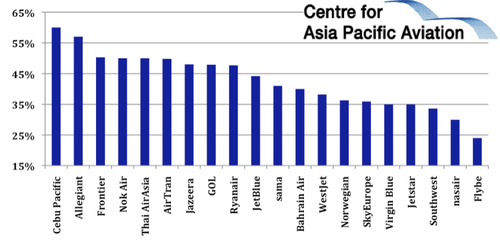
The carrier has also benefited from its investment in modern aircraft, with the carrier stating it would have GBP33 million in additional fuel expenses if it still operated its 2002 fleet.
Solid performance enhancing ancillary revenue
On the revenue side, a solid performance in enhancing ancillary revenue has helped, with the airline's ancillary revenue per passenger increasing 305 year-on-year to GBP7.87.
Flybe ancillary revenue/pax: 2003-08 (12 Months ended 31-Mar-08)
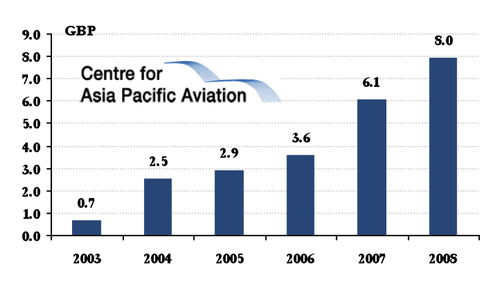
Predominant reliance on British market a concern
By right-sizing the aircraft for the routes it operates and providing low fares, Flybe maintains it is well placed to rob from the rich as well as the poor, by both picking up the cost sensitive business traveller and attracting discretionary travellers by providing service at a price not much higher than the lowest-fare LCCs.
The fact that anything from 20-45% of traffic is identified as business travellers, offers some comfort, but the sodden UK economy will be dragging that market down. It is here that Flybe's biggest challenge comes. Unlike its larger rivals, it is still predominantly reliant on the British market, with some 86% of its capacity flying into or from UK airports.
Flybe route capacity share (Seats) by country: Week commencing 08-Sep-08
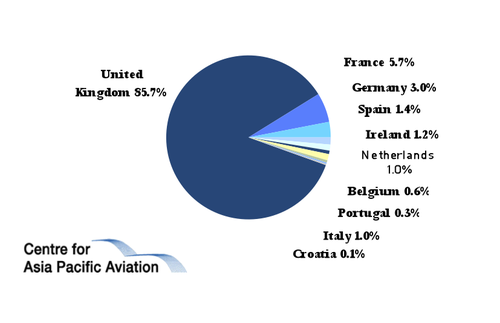
However, Flybe plans to expand internationally from key airports in the coming months, with the planned launch of service from Newcastle to destinations in Scandinavia and Germany (the airline also expects to add a fourth daily Newcastle-London Gatwick service after investing GBP2 million in acquiring landing slots for the route from Jet2.com). Flybe also plans to increase operations at Newcastle, from the current 22 daily services covering ten destinations, with the addition of additional European destinations.
Moving forward cautiously and understatedly
Flybe reckons that one of its differentiators is "regional not radial", the carrier's self-description on its website. That could also read "stirred, not shaken". Flybe is gently stirring the market, without setting out to shake its foundations, manoeuvring between the bigger operators and paying attention to detail as only a small carrier can do (although not all do).
By picking the eyes out of many of the better strategies - low cost profile, network planning, frequency, good yield mix with product to match, loyalty strategy, cautiously tailored operating relationships - it has been able to sit on the fence without suffering the pain that often goes with that position. As a contrast of styles, the Ryanair model, whose low cost approach it broadly follows, sits at the opposite end of the spectrum.
Priding itself on an advanced IT attitude, it has however provocatively challenged Ryanair's opposition to screen scraping, actively encouraging online third party web sales. Flybe is in the throes of developing an XML-based web option designed to provide direct access to its own booking engine and live inventory. It also actively pursues one-on-one interline arrangements with a secular array of long haul airline partners, including American Airlines, British Airways, bmi, Brussels Airlines, Emirates, Korean Air, Northwest, Singapore Airlines, TAP, US Airways and Virgin Atlantic.
Flybe's interline partners: Sep-08
| |
|
|---|---|
|
Hahn |
|
|
|
Flybe's style is very much a reflection of its management - cautious and understated. In implementation it is more a mini-Southwest Airlines, without the embellishment of Herb Kelleher. But that style has also enabled a transition from an unexciting but successful regional airline, Jersey European Airways, into a regional low cost operation in 2002, when LCCs threatened to steamroller all sizes of market. The success of that process gives Flybe an ancestry that now stretches back almost 30 years.
Focus on business-friendly high frequency network
The carrier's traffic growth has been strong if not stellar, with consistent attention to frequency (to suit its business following) and a design to accumulate regional networks.
Flybe passenger numbers: 2003 to 1Q09 (12 months ended 31-Mar-08)
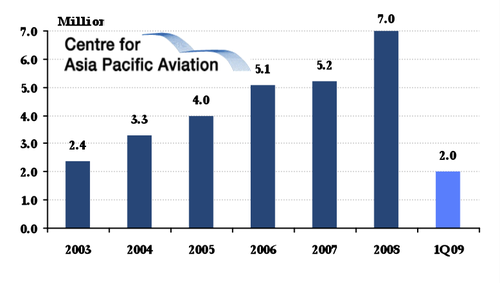
According to Flybe, the majority its passengers travel with the airline regularly and consequently its network has been designed with a focus on offering high frequency connectivity to city-centre destinations. This focus was devised after Flybe' research found a slowdown in demand for tourist travel that had been stimulated by low fares. Mr Rutter previously stated the carrier was "clear a couple of years ago that consumer appetite for visiting places they'd never heard of would wane, dented by a weakening economy and a consumer backlash to the low-grade service attitude of some of the hard-core low cost airlines".
Accordingly, over 80% of Flybe's capacity is deployed on frequencies of twice or more per day, with approximately 50% on four or more daily services. A small proportion of capacity (less than 16%) is dedicated to the discretional and very price sensitive traveller on frequencies of daily or less. According to Flybe, these routes that are the most risky, as they are more vulnerable to economic downturns.
Forecasting 8 million passengers in 2008
Meanwhile, Flybe forecasts an overall 11% increase in passenger numbers during the European Summer, boosted by the additional 10% year-on-year increase in ticket sales over the Bank Holiday weekend (25-Aug-08 until 28-Aug-08). The LCC experienced particularly strong demand on services from Exeter and Southampton to Spain and France.
The airline is targeting carrying 8 million passengers in 2008, with the airline previously stating it has the "very beneficial position of picking up those [passengers] who are downshifting from the majors on a price basis - a lot from Lufthansa and Air France, and the legacy carriers. We also get a lot up-shifting from 'hardcore' low-cost carriers because our prices aren't that far away, but we provide a better product/service balance".
BA Connect and Loganair helping Flybe increase market presence
The BA Connect acquisition clearly gave capacity a boost, after stagnating in the previous year. Following the acquisition, Flybe's market presence has spread considerably, including substantial growth in the North West of England and continued growth in the airline's network to/ from Scotland. In addition, the airline now has a significant network from the UK regions to the major commercial centres of Europe, serving 33 European airports in 2007/08.
Flybe destination map
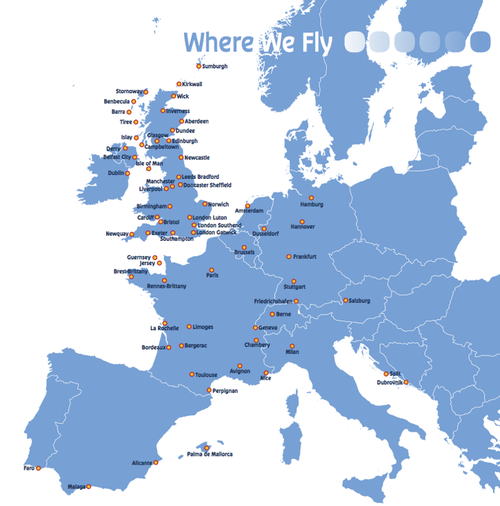
And the low-risk franchise agreement with Scotland's Loganair will further expand the de facto network of each carrier, hopefully leading to an increased overall pie and benefits for both sides. Flybe plans to operate 25 Loganair routes "under Flybe colours" for the first time from 26-Oct-08 including:
- Glasgow to Islay, Tiree, Campbeltown, Barra, Benbecula, Stornoway;
- Orkney, Shetland, City of Derry and the Isle of Man;
- Edinburgh to Inverness, Orkney, Shetland, Wick and Isle of Man;
- Aberdeen to Orkney and Shetland;
- Inverness to Orkney, Shetland, Stornoway and Edinburgh;
- Orkney to Shetland and Barra to Benbecula.
Neither carrier has been forthcoming about the term of the new arrangement, but Loganair stayed with British Airways in a similar franchise for 14 years, so its management is familiar with the concept, expecting this also "to be a long term commitment". Flybe simply receives a payment per passenger flown on the Saab 340s, while enhancing its network without major capital cost.
This is a sensible strategy in the present conditions - and Loganair probably wouldn't have gone any further at a reasonable price - but, although it helps Flybe's cash flow, it won't permanently lock in a bigger profile for a company which would be Europe's largest regional. For that is what this airline wants to become.
Likely acquisition target
That - and profitability - may eventually set it up for the ultimate goal of an IPO (apparently still on track, albeit somewhat optimistically in present conditions, with financial advisers appointed) or, more likely, to become an acquisition target as a combination of EU liberalism and North Atlantic open skies exposes UK markets to more participants.
Who knows, British Airways may well be back soon to claim what it has relinquished in the past couple of years. If not BA, there will be a number of acquisitive large airlines looking to complement their long haul connections. And, by advertising its wares through its numerous interline arrangements, Flybe makes sure that it remains well on the radar.
Michael O'Leary may be in a minority in making the call that Flybe will be an early casualty of Europe's economic downturn. However, Mr Rutter has scotched the "doom and gloom rumours", stating his carrier has been preparing for these challenges for the past five years, and have comprehensive strategies in place to "ride out the current economic turbulence".
But, sitting on a slender GBP67.4 million in cash (a 102% year-on-year reduction, although this balance included GBP96.0 million of cash received from BA upon the acquisition of BA connect on 05-Mar-07), the wannabe biggest little airline will have to use all of its extensive ingenuity to repeat this year's financial performance in 2009.
Background Information:
- Flybe commenced operations in 1979, rebranding to Flybe in 2002;
- Following its acquisition of BA Connect in Mar-07, Flybe operates 168 routes (and over 470 daily services) from 23 UK and 33 European Airlines, covering 12 countries;
- The leading UK domestic regional carrier with over 35% of the domestic market outside London;
- Flybe is the largest scheduled airline at Birmingham, Exeter, Norwich, Southampton, the Channel Islands and Belfast City;
- The airline's route network comprises 73% domestic UK, 20% European city routes and 7% European leisure destinations;
- The airline carried 7 million passengers in 2007/08;
- Since 2002, Flybe has reported passenger growth of 24% compound p/a, ancillary revenue growth of 63% compound p/a and turnover growth of 25% compound p/a;
- Has committed to over USD1.9 billion of firm aircraft orders (60 Bombardier Q400s and 16 Embraer 195s), which will be delivered by the end of 2009;
- Operates a fleet of 80 aircraft.